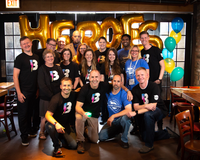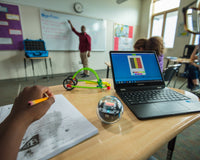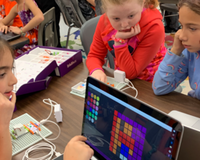With hybrid learning environments becoming a new normal — how can you be sure your remote learners are getting the education they need while learning from home? Enter virtual STEM projects.
By implementing these STEM projects for kids (interactive projects based on science, technology, engineering, and math) into your lesson plans, you can ensure your remote students are gaining the 21st century skills they need to become innovators of tomorrow — especially in our technology-driven world.
Thankfully, the STEM-based learning experts at Sphero are here to help you find new and exciting ways to implement STEM projects into your virtual or hybrid learning environment. With these 19 activities in the queue for your school year, you can rest assured your students are on their way toward a bright future.
The Importance of STEM Projects and 21st Century Skills
Because these STEM projects nurture your students’ 21st century skills, your class will be better equipped to solve complex problems, think critically, and make decisions that will help them reach new heights — at home or in the classroom. A recent study about skill development shows that students need to have proper digital skills such as technological literacy to effectively develop other 21st century skills.
These skills include:
- Learning Skills
- Creativity and innovation
- Critical thinking and problem-solving
- Communication and collaboration
- Literacy Skills
- Information literacy
- Technological literacy
- Information and communication technology (ICT) literacy
- Life Skills
- Flexibility and adaptability
- Initiative and self-direction
- Social and cross-cultural skills
- Productivity and accountability
- Leadership and responsibility
STEM Project Ideas for Kids
Although many of your students might be learning outside of the classroom, these 19 virtual STEM challenges will keep their remote school days exciting, entertaining, and thought-provoking while developing students’ 21st century skills.
Teacher’s Note: For these STEM projects, you can do things like setting up pre-recorded videos that walk your students through project processes, add additional subject matter that’s relevant to each project, and have your students work together remotely via programs like Google Hangouts or Zoom. And, while these activities can be used in virtual learning environments, they can also be used for socially-distanced, in-person instruction.
1. Galileo and Gravity
In this virtual STEM project, your students will discover the power of our planet’s gravitational pull while dropping a tennis ball and golf ball onto an audible surface.
2. Bubble Flute
With a few simple materials and the littleBits Base Inventor Kit, your remote students can use the sound of their voice to create bubbles in this virtual activity. This activity allows them to experiment with sound waves and learn how common items interact with each other to make something new.
3. Mission Morse Code
As one of the most well-known coded languages, morse code can help your kids develop their STEM skills right at home. During virtual instruction, you can explain the history of morse code and how to convey a message with it. Then, your class could communicate simple words or phrases using a flashlight or hand-drawn codes to their online peers.
4. Maze Mayhem

Using masking tape, everyday objects, and open floor space, this activity allows your students to create their very own wacky maze and program a Sphero robot to navigate through it successfully.
5. Slime Time
Using a few simple ingredients, your remote students can follow specific measurements to create stretchy slime. Did we mention they will learn about non-Newtonian fluids and chemical reactions at the same time?
6. Portal Programming
For this social distancing STEM project, you will construct a maze out of painter’s tape on the floor of any available space. Then, you will send your remote students the exact measurements of the maze, along with detailed photos from multiple angles and the distance your Sphero robot travels at half-speed for one second. Finally, using the data provided, your students can work together remotely to program Sphero virtually in real time.
7. Matching Numbers
With a few post-it notes, tape, poster paper, and a marker, your remote students can physically match numbers on post-its to corresponding dots on the poster paper.
8. BOLT Mind Control
Using two Sphero BOLTs, your remote students can learn about the power of coding with basic block programs that highlight BOLT’s infrared technology.
9. Brain Sidedness
In this STEM project, students can find out if they are left-brained or right-brained. With paper, a writing utensil, a penny, a paper towel tube, and a seashell or phone, your class can find out if they have a sidedness.
10. Spheroraptor Escape
This Sphero activity teaches your remote students all sorts of coding knowledge, including using loops, conditionals, operators, and comparators. Using common objects at home, your students will develop a code that keeps their Sphero BOLT contained within a pen, as well as develop a code that tells their dino-robot to escape.
11. Measure Footprints
In this STEM challenge, you can provide your virtual students with illustrations of different animal footprints. Using a ruler, they can measure each footprint and compare sizes to different animal types. Then you can encourage your remote class to trace and measure their own footprints and share their results with their peers.
12. Balancing Objects
With a couple of common household items including a plastic hanger, paper or plastic cups, and some string, your students can make a DIY scale to discover the weight and density of various objects.
13. Bridge Challenge
In this remote activity, your virtual students will build a bridge using common household supplies (such as tape, string, glue, popsicle sticks, and more) and program their Sphero robot to drive across it.
14. Egg Drop Challenge
Known as the classic STEM project, the egg drop challenge gives your remote students the chance to create a contraption that will protect an egg from a large fall — all while using common materials like string, balloons, paper towel rolls, tape, and more.
15. BOLT: Light Sensor
With flashlights or other portable light sources (cell phones work well), this activity allows your remote students to discover BOLT’s ambient light sensor. This light sensor allows BOLT to sense the amount of light it is exposed to during a program, which means light can act as a trigger for conditionals or dynamic functions.
16. Marshmallow Towers
With this remote activity, your students can build towers out of marshmallows and toothpicks as high as they can. When certain areas become unstable, they will have to think critically to discover how to stabilize the structure.
17. Robot Realization
This Sphero Edu activity allows your students to draw shapes that represent code and execute that code using their Sphero robot. Your learners are tasked with designing a unique robot made of shapes and program Sphero to draw it using the Draw canvas.
18. Animal Imitation
With this hands-on STEM project, your class will study the movements of their favorite animal and program RVR to mimic how this animal navigates in the wild. In addition, your students will also be able to utilize littleBits inventions to mimic this animal’s behavior.
19. Mars Mission
This exciting project is a great way to introduce your in-person or remote students to the power of a Sphero robot, as well as get a handle on programming through block codes and loops. Additionally, this activity pairs well with lessons about space or as part of a wider STEM lesson plan.
Incorporate STEM Projects Into Your Lesson Plans Today

STEM skills are imperative for your students in the 21st century, as society has transformed from an economy based on commodities and manual labor to one rooted in knowledge and a highly qualified, adaptable workforce. Thankfully, with a little help from these STEM projects and our STEM kits for virtual learning environments, you can easily teach your remote students invaluable 21st century skills that elicit whole-brain thinking and a future filled with success.
Visit our socially distanced resources list to learn more about how to incorporate Sphero in your classroom today!
Sources:










